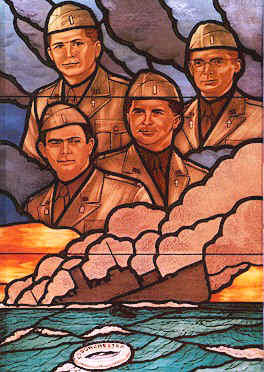Sarah Sundin's Blog, page 104
February 7, 2023
Today in World War II History—February 7, 1943

British poster, WWII
80 Years Ago—Feb. 7, 1943: In Allied Convoy SC-118 off Iceland, a wolf-pack attack by German U-boats leads to the loss of seven Allied ships and one U-boat.
US announces shoe rationing will begin on February 9—each person can purchase three leather pairs per year. (See Make It Do—Shoe Rationing in World War II).
The post Today in World War II History—February 7, 1943 first appeared on Sarah Sundin.February 6, 2023
Make It Do – Shoe Rationing in World War II

During World War II, many items were rationed in the United States, including shoes.
Why Shoe Rationing?
US poster urging mending clothes, 1943
Due to the serious rubber shortage (Make It Do-Tire Rationing in World War II), footwear made of rubber or with rubber soles was rationed or unavailable. Also, the military had a high need for leather, not just for shoes and combat boots, but for those popular leather flight jackets. As a result, civilians made do with less.
Rationing of Rubber Footwear
US poster encouraging conservation of rubber, WWII
Starting September 30, 1942, men’s rubber boots and rubber work shoes were placed under rationing. To obtain a new pair, a man had to apply to the local ration board, prove he needed the shoes for essential industry—not for sport—and turn in the old pair. Galoshes and overshoes were not rationed because they used less crude rubber, but sportsmen couldn’t purchase boots, and sneakers were no longer produced.
Shoe Rationing
US rationing books owned by my mother and grandmother, WWII (Photo: Sarah Sundin)
On February 7, 1943, the United States instituted rationing of leather shoes to begin on February 9. Each man, woman, and child could purchase up to three pairs of leather shoes a year, using designated stamps in War Ration Book One, and later in Books Three and Four. To simplify the system, only six shades of leather were produced. However, the supply of leather continued to decrease. On March 20, 1944, the ration was reduced to two pairs of leather shoes per year. Shoe rationing continued until October 30, 1945.
ExceptionsThe strict rule that the ration stamp had to be torn from the book in the presence of the retailer was lifted for catalog purchases. If you wanted an extra pair of shoes, you had to fill out a long application at the ration board, listing every pair of footwear you owned, and explaining why another pair was essential for your occupation and why another pair was required to prevent serious hardship.
What about Children?
US poster promoting war bond sales, 1942
No exceptions were made for children and their rapidly growing feet. Families pooled their stamps, and adults made do with fewer shoes to provide for their children’s needs. However, pediatricians and podiatrists complained publicly that shoe rationing would produce a generation of “foot cripples.”
Making Do
Ad for unrationed shoes, WWII
To make do with less, people took care of the footwear they already owned, keeping rubber boots clean, dry, and away from excess heat or cold, and repairing shoes and boots whenever possible. Shoes made of fabric, such as espadrilles, were not rationed and became fashionable. Women also turned to fabric purses and belts.

US poster, 1943 (Franklin D. Roosevelt Presidential Library, MO 2005.13.42.2.1)
Some people did not make do. Theft and black market profiteering were a continuing problem. For example, on May 3, 1944, a man was arrested in Pittsburg, California, for stealing seven pairs of shoes from a shipment. The June 8, 1944 issue of the Antioch Ledger reported his sentence—six months or $500.
Tales from a Shoe Store
Ad for GallenKamp’s Shoe Store, Seattle Times, 1943
This story comes from Charles Martin, who worked as a stock boy in a shoe store while he was in high school (1941 to 1943). He gave me permission to share his experiences.
“When the current stamp was about to expire, there would be a rush, mostly by women, to buy any pair of shoes, whether they fit or not. Later, when we got in new styles, they would exchange the ones they had bought for the new ones. Finally the store had to put a time limit on how long the first pair could be exchanged. The store would run ads in the paper when a new shipment of shoes was expected, and women would line up that morning to get a shot at the newest. Sometimes things got a little difficult because there would only be a few pairs in the most common sizes. More than once there were unpleasant situations that made the shoe clerk nervous.”
How would you do with only two or three new pairs of shoes a year?The post Make It Do – Shoe Rationing in World War II first appeared on Sarah Sundin.Today in World War II History—February 6, 1943

Count Galeazzo Ciano and his wife Edda Mussolini, date unknown (public domain via WW2 Database)
80 Years Ago—Feb. 6, 1943: In Italy, Mussolini removes his son-in-law, Count Galeazzo Ciano, as foreign minister and takes over his duties.
US movie premiere of Disney’s Saludos Amigos in Boston (premiered in Rio de Janeiro, Brazil, 24 Aug 1942).
The post Today in World War II History—February 6, 1943 first appeared on Sarah Sundin.February 5, 2023
Today in World War II History—February 5, 1943

80 Years Ago—Feb. 5, 1943: Nazis begin liquidating the Bialystok ghetto; 1,000 Jews are killed and 10,000 are sent to Treblinka extermination camp.
Members of CS-6 Dutch resistance group shoot Dutch Gen. Hendrik Seyffardt, commander of Dutch Legion of the SS; Seyffardt dies the next day.
The post Today in World War II History—February 5, 1943 first appeared on Sarah Sundin.February 4, 2023
Today in World War II History—February 4, 1943

Gen. Bernard Montgomery during a visit to England, 1943 (Imperial War Museum: TR 1037)
80 Years Ago—Feb. 4, 1943: British Eighth Army under Gen. Bernard Montgomery crosses from Libya into Tunisia.
US European Theater of Operations (ETO) branches into North African Theater of Operations (NATO) in North Africa and Mediterranean under Lt. Gen. Dwight Eisenhower and ETO (Britain, Iceland, and continental Europe except Italy) under Gen. Frank Andrews.
The post Today in World War II History—February 4, 1943 first appeared on Sarah Sundin.February 3, 2023
Today in World War II History—February 3, 1943

Four Chaplains stained-glass window at the US Pentagon (US government photo)
80 Years Ago—Feb. 3, 1943: US Army troop transport Dorchester is sunk by German U-boat U-223 off Greenland, 675/904 killed; four chaplains of different faiths give away their life jackets and go down with the ship, arms linked and offering prayers.
Britain allows 5000 Bulgarian Jews, mostly children, to emigrate to Palestine.
The post Today in World War II History—February 3, 1943 first appeared on Sarah Sundin.February 2, 2023
Today in World War II History—February 2, 1943

German soldiers marching to a Soviet prisoner of war camp, Stalingrad, Russia, Feb 1943 (German Federal Archive: Bild 183-E0406-0022-010)
80 Years Ago—Feb. 2, 1943: German 6th Army surrenders to the Soviets in Stalingrad—91,000 prisoners are taken, of whom only 5000 will survive the war.
Australians counterattack at Wau, New Guinea.
The post Today in World War II History—February 2, 1943 first appeared on Sarah Sundin.February 1, 2023
What I Would Tell You by Liz Tolsma

When Tessa Payton takes a DNA test, it reveals she’s Greek – which she knows – and Jewish – which she did not know. All Tessa knows is that her great-grandmother immigrated right after World War II. Not only does Tessa’s mother shed no light on the subject, but she urges Tessa to drop the matter. Tessa does not. Emptying her savings, Tessa buys a ticket to Thessaloniki, Greece. There, to help Tessa understand the Jewish community during the war, the handsome curator of the Jewish museum gives her a journal belonging to Mathilda Nissim.
When the Nazis invade Greece, newlywed Mathilda is horrified that no one resists. She’s heard rumors of horrible things happening to Jews throughout Europe, so she decides to spread the word and publish an underground newspaper. But soon Mathilda and her husband Asher are confined to the ghetto, and hunger takes hold. And when Mathilda finds out she’s expecting a baby, she faces an uncertain future for her daughter.
Rich in historical research and vivid in setting, Liz Tolsma‘s What I Would Tell You illuminates the horrifying plight of the Jews in Thessaloniki during World War II. Mathilda and Tessa, though separated by eighty years, share determination and compassion and a longing for family. Tessa’s search and Mathilda’s striving make the novel difficult to put down. I strongly recommend this heartfelt tale.
The post What I Would Tell You by Liz Tolsma first appeared on Sarah Sundin.Today in World War II History—February 1, 1943

Insignia of the US 442nd Regimental Combat Team
80 Years Ago—Feb. 1, 1943: Japanese begin evacuation of 13,000 troops from Guadalcanal.
Mussolini dismisses Gen. Ugo Cavallero as head of Italian armed forces (Comando Supremo), and replaces him with Gen. Vittorio Ambrosio.
US forms 442nd Regimental Combat Team for Japanese-American soldiers, including internees.
The post Today in World War II History—February 1, 1943 first appeared on Sarah Sundin.January 31, 2023
Today in World War II History—January 31, 1943

German Field Marshal Friedrich Paulus, Maj. Gen. Arthur Schmidt, and Col. Wilhelm Adam after their surrender, Stalingrad, Russia, 31 Jan 1943 (German Federal Archive Bild 183-F0316-0204-005)
80 Years Ago—Jan. 31, 1943: Karl Dönitz takes command of German Navy and is promoted to Grossadmiral, maintaining his position as Commander of U-Boats.
Soviets take southern pocket in Stalingrad and capture Field Marshal Friedrich Paulus, commander of German 6th Army.
Germans take Faïd and Pichon Passes in Tunisia.
The post Today in World War II History—January 31, 1943 first appeared on Sarah Sundin.


